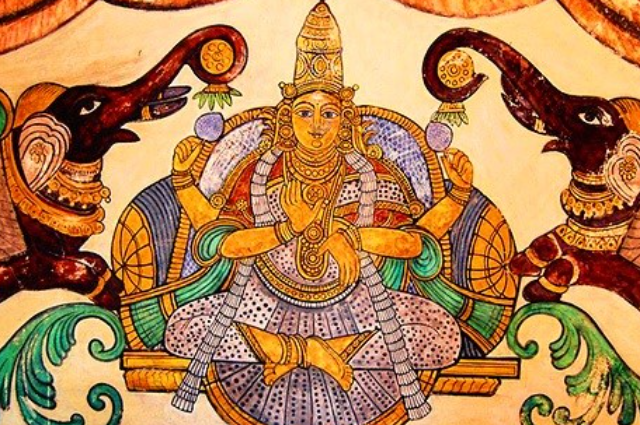
Hues of cerulean and crimson gleam against the aged fawn backdrop as the resplendent figure of the Goddess Lakshmi; the deity of wealth captivates those who glance upon the fervent piece with each indent and brushstroke rippling with artistic fervor and vibrant outpourings. Etched into the wooden plank glimmers a tale of a glorious past, the glass beads and precious gems embedded into the frame reflect the rich history of Tamil Nadu; the coruscating kaleidoscope of the town of Thanjavur.
Thanjavur is a haven for the arts; home to the expansive Brihadisvara Temple (Pervudaiyar koyil) built by Raja Raja Chola I which stands upright as an exemplary piece of Tamil architecture. On the sanctum walls along the circumambulatory pathway lay sprawled; magnificent pieces retelling tales of riveting victories and omniscient Gods, masterfully brought to life by impassioned artists a millennium ago. The blooms of Thanjavur art sprouted amidst those very walls in the 11th century; its expansive roots sprawling across centuries, dynasties and eras; acquiring new facets and historical spheres. After the Cholas; the art form acquired a zenith under the Vijayanagara Rayas who were devoted to older Hindu artistic traditions, specifically emphasized by the munificence of Emperor Krishnadevaraya. The art was further expanded by the Maratha kings; who after defeating the Thanjavur Nayakas, nurtured the atelier under their patronage that led to an exponential creative growth as local cultures and artistic preferences were absorbed; with the art form gradually transcending the borders from temple venerations into major buildings, palaces, chatrams and residences of the Maratha kings and nobility. After the gradual wane of the massive Maratha reign; the patronage was transferred to the mercantile Chettiar community; with colossal painting gracing their monasteries. The Britishers who had come into Thanjavur in the wake of the Anglo-Mysore wars also patronized Thanjavur artists and their paintings.
Thanjavur paintings are characterized by their bright colors and dynamic compositions, that often relay either myths, legends, or tales of the ancient and devoted renditions of deities and Gods. They have an aesthetic variety; be it their sizes, subjects, or patrons. Thanjavur paintings departed from traditionally small Pan-Indian scale of artwork; accentuated by semi-precious gems, gold foils, and glass beads with an exquisite sophistication. The art form majorly lay a focus on the subject of the project itself rather than the intimate surroundings; with backgrounds often layered with flat colors; though certain pieces from the 19th century focused on arches, drapes, and ornate borders to aptly compliment the main portraits, the Nataraja and Sivakami painting one such example. Rounded faces, almond-shaped eyes, and shaded skin tones were a popular approach with well-crafted details rendering meticulously designed ornaments and accessories. Initially largely painted on wooden planks of teak and jackfruit (rightly named as palagai padam); the paintings later found themselves over walls, metals, glass, mica, and even ivory. Brightly tinted vegetable colors soon found themselves replaced by exotic mineral pigments; often in brilliant shades of reds, blues, and greens that framed the vibrant palette that composited the impressive works. The Thanjavur style; with its immense attention to detail ensures that monotony does not envelope a piece as even those with limited color variations relay richness and extravagance.
The art style boasts of a diverse stylistic influence due to a migrant artistic community; both Indian and international. While the art style itself drew heavy influence from the Kalamkari and Tirupati styles and being gilded and gem-set similar to the Mysore style of artwork; the production process was inspired by the Chinese reverse glass painting technique as a faster and more accurate way of production. In recent years; Thanjavur paintings continue to uphold a massive appeal; only now synthetic pigments, canvases, and plywood replacing the mediums of the past. In recent times, they have been commercialized extensively and can be found being sold even in street markets; essaying a magnificence still so spectacularly grand.
